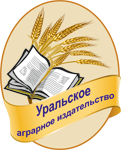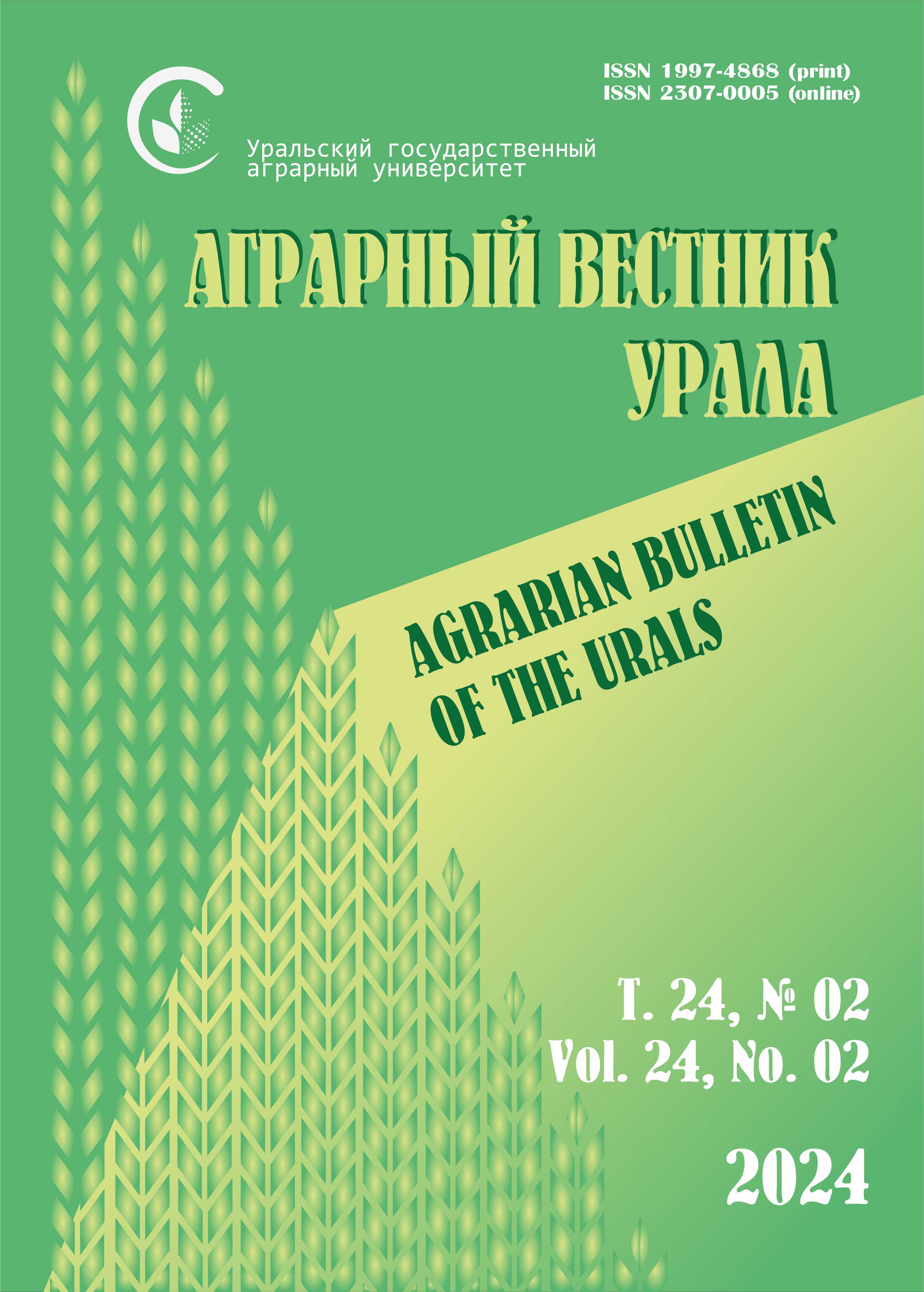Saint Petersburg, Russian Federation
Abstract. The paper considers the possibility of using neural network structures of an artificial intelligence system for processing photometric data of remote sensing of winter rye crops grown in the conditions of the Leningrad Region on the field of the educational and experimental garden of Saint Petersburg State Agrarian University in 2014–2015. In the process of cultivating plants, various types of treatments were applied: the application of mineral fertilizers, microelements and a microbial biological product. To process the photometric data, the Rosenblatt perceptron was used, which analyzes the similarities and differences in the photometric NDVI profiles of winter rye crops obtained from different variants of the experiment. According to the numerical indicators of vegetation indices, it was possible to construct phase portraits of the trajectory of their movement on the coordinate plane of the field. Further cluster analysis of the data obtained, converted into a square matrix of paired Euclidean distances, made it possible to identify on the dendrogram a grouping of variants in which the connecting components were the use of a microbiological inoculant. When using a biological product, there is a more complete development of plants in crops and their evenness in the field improves. The minimum coefficient of variation was observed for the variant without the use of a biological product, but with the joint use of a complex of all mineral fertilizers (50 phosphorite flour + 50 KCl + 50 ammonium nitrate) and microelements at a dose of 250 kg/ha. Based on the results of the analysis, it can be concluded that the images of the trajectories of the points of the NDVI profiles provide qualitative information reflecting the dynamics of the ontogeny phases of winter rye plants. Based on the nature of the selected sections of these trajectories, it is possible to create a digital map of the experimental field, with the help of which to conduct a protocol for remote diagnostics of the state of crop productivity and make a forecast of their yield during harvesting.
spatial photometric NDVI profile, Secale cereale (W) L; Rosenblatt perceptron
1. Kargatova A. M., Stepanov S. A., Ermolaeva T. Ya., Nuzhdina N. N. Biologicheskie osobennosti produktivnosti razlichnyh selekcionno-geneticheskih form ozimoy rzhi // Izvestiya Saratovskogo universiteta. Novaya seriya. Seriya: Himiya. Biologiya. Ekologiya. 2017. T. 17. № 1. S. 48-52. DOI: https://doi.org/10.18500/1816-9775-2017-17-1-48-52; EDN: https://elibrary.ru/YKKIYD
2. Tursumbekova G. Sh. Allelopaticheskoe vliyanie vytyazhek sornyh rasteniy na semena i prorostki zernovyh kul'tur // Agroprodovol'stvennaya politika Rossii. 2014. № 4 (28). S. 38-40. EDN: https://elibrary.ru/SXJYZF
3. Storchak I. G., Shestakova E. O., Eroshenko F. V. Svyaz' urozhaynosti posevov ozimoy pshenicy s NDVI dlya otdel'nyh poley // Agrarnyy vestnik Urala. 2018. № 6. C. 64-68. DOI:https://doi.org/10.25930/awm3-sw92. EDN: https://elibrary.ru/XRSJOH
4. Mihaylenko I. M., Voronkov I. N. Nauchno-metodicheskie i algoritmicheskie osnovy ocenivaniya pokazateley produktivnosti i fitosanitarnogo sostoyaniya posevov po dannym distancionnogo zondirovaniya zemli // Agrofizika. 2016. № 1. S. 32-42. EDN: https://elibrary.ru/VQXNSN
5. Paul K., Chatterjee S. S., Pai P., Varshney A., Juikar S., Prasad V., Dasgupta S. Viable smart sensors and their application in data driven agriculture // Computers and Electronics in Agriculture. 2022. Vol. 198. Article number 107096. DOI:https://doi.org/10.1016/j.compag.2022.107096. EDN: https://elibrary.ru/ZNMMDY
6. Muñoz-Huerta R. F., Guevara-Gonzalez R. G., Contreras-Medina L. M., Torres-Pacheco I. L., Prado-Olivarez J., Ocampo-Velazquez R. V. A Review of Methods for Sensing the Nitrogen Status in Plants: Advantages, Disadvantages and Recent Advances // Sensors. 2013. Vol. 13. Pp. 10823-10843. DOI:https://doi.org/10.3390/s130810823.
7. Abramov N. V., Semizorov S. A., Sherstobitov S. V., Gunger M. V., Petuhov D. A. Ispol'zovanie bespilotnogo letatel'nogo apparata dlya monitoringa za sostoyaniem agrocenozov i sostavleniya elektronnyh kart poley // Zemledelie. 2021. № 8. S. 8-12. DOI:https://doi.org/10.24412/0044-3913-2021-8-8-12. EDN: https://elibrary.ru/MIXXYN
8. Wang R., Cherkauer K., Bowling L. Corn Response to Climate Stress Detected with satellite based NDVI series // Remote sensing. 2016. Vol. 23. Rp. 269-287. DOI:https://doi.org/10.3390/rs8040269.
9. Ghanem M. E., Marrou H., Sinclair T. R. Physiological phenotyping of plants for crop improvement // Trends in Plant Science. 2015. Vol. 20. No. 3. Pp. 139-144. DOI:https://doi.org/10.1016/j.tplants.2014.11.006.
10. Koptilina D., Bulgakov A., Aleshina A. “Big data” and the “Internet of things”, or what accelerates the development of the agro-industrial complex // IOP Conference Series: Earth and Environmental Science. 2019. Vol. 274. No. 1. Article number 012058. DOI:https://doi.org/10.1088/1755-1315/274/1/012058. EDN: https://elibrary.ru/LPMSPJ
11. Zolkin A. L., Burda A. G., Avdeev Y. M., Fakhertdinova D. I. The main areas of application of information and digital technologies in the agro-industrial complex // IOP Conference Series: Earth and Environmental Science. 2021. Vol. 677. No. 3. Article number 032092. DOI:https://doi.org/10.1088/1755-1315/677/3/032092. EDN: https://elibrary.ru/BDFNDZ
12. Stovba E. V., Sharafutdinov A. G., Gorbunova O. S., Araslanbaev I. V., Stovba A. V., Damineva E. R. Rol' cifrovyh tehnologiy v razvitii deyatel'nosti sel'skohozyaystvennyh tovaroproizvoditeley // Vestnik Altayskoy akademii ekonomiki i prava. 2021. № 3-2. S. 225-232. DOI: https://doi.org/10.17513/vaael.1634; EDN: https://elibrary.ru/RVYRWC
13. Yakushev V. P., Yakushev V. V., Matveenko D. A. Intellektual'nye sistemy podderzhki tehnologicheskih resheniy v tochnom zemledelii // Zemledelie. 2020. № 1. S. 33-37. DOI:https://doi.org/10.24411/0044-3913-2020-10109. EDN: https://elibrary.ru/LYKCTT
14. Van Klompenburg T., Kassahun A., Catal C. Crop yield prediction using machine learning: A systematic literature review // Computers and Electronics in Agriculture. 2020. Vol. 177. Article number 105709. DOI:https://doi.org/10.1016/j.compag.2020.105709.
15. Malhi G. S., Kaur M., Kaushik P. Impact of climate change on agriculture and its mitigation strategies: A review // Sustainability. 2021. Vol. 13. No. 3. Article number 1318. DOI:https://doi.org/10.3390/su13031318. EDN: https://elibrary.ru/DXYSFP
16. Karimi V., Karami E., Keshavarz M. Climate change and agriculture: Impacts and adaptive responses in Iran // Journal of Integrative Agriculture. 2018. Vol. 17. No. 1. DOI:https://doi.org/10.1016/S2095-3119(17)61794-5.
17. Brühl C. A., Zaller J. G. Biodiversity decline as a consequence of an inappropriate environmental risk assessment of pesticides // Frontiers in Environmental Science. 2019. Vol. 7. Article number 177. DOI:https://doi.org/10.3389/fenvs.2019.00177.
18. Wu Y., Feng J. Development and application of artificial neural network // Wireless Personal Communications. 2018. Vol. 102. Pp. 1645-1656. DOI:https://doi.org/10.1007/s11277-017-5224-x. EDN: https://elibrary.ru/JBMMGU
19. Saltykov M., Yakubailik O., Bartsev S. Identification of vegetation types and its boundaries using artificial neural networks // IOP Conference Series: Materials Science and Engineering. 2019. Vol. 537. No. 6. Article number 062001. DOI:https://doi.org/10.1088/1757-899X/537/6/062001. EDN: https://elibrary.ru/RLDJFQ
20. Esau T. J., Hennessy P. J., MacEachern C. B. Artificial intelligence and deep learning applications for agriculture // Precision Agriculture. Academic Press, 2023. Pp. 141-167. DOI:https://doi.org/10.1016/B978-0-443-18953-1.00003-9.










